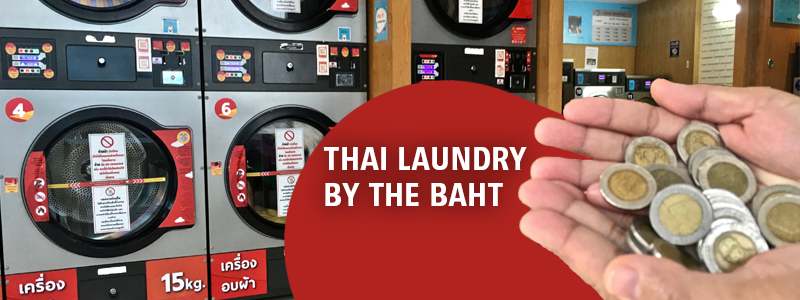Thai laundry by the baht

To truly appreciate laundromats you’ve gotta hit up Thailand.
Talk about booming. The country’s 3,000 stores are projected to triple by 2030. Market leader Otteri Wash & Dry is setting a blistering pace with 750 operating branches and 150 more start-ups before year’s end.
This Southeast Asian nation of 70 million isn’t new territory for me. Back in 1994 I chronicled the debut of its first coin-op. Now I’m hard pressed to find a metro area without one.
Thai laundromats may be young, but they follow the age-old KISS principle to keep things simple.
What better example than the bill changer, where patrons turn their hard-earned money into ten-baht coins for washing and drying. Quick and easy — the same way it’s been done across the globe for more than half a century.
You might be surprised to learn that alternative pay technology doesn’t dominate the world’s fastest-growing laundromat market. Just like in the states, coins drive sales here. A typical store operated by the country’s largest chain derives 70% of its revenue by the baht.
That’s not to say smartphone pay hasn’t made significant inroads. Proprietary apps do get tapped — about 30% adoption at Otteri’s mainstream outlets and up to 75% near universities.
History repeating itself
The rise of Thailand’s self-service laundry industry mirrors America’s. Both blossomed from multi-family housing roots and grew exponentially through turnkey store marketing.
In the 1940s, New York City apartment building basements served as the proving ground for metered washers and dryers. The success enjoyed by those early route operators ushered in coin-op’s golden era as developers brought thousands of vended storefronts to main street — Telecoin’s Bendix-equipped Launderettes, Westinghouse’s licensed Laundromats and Norge’s colorful Laundry and Cleaning Villages.
While the brands varied, they all had one thing in common: Coins. Generations of users came to expect laundry paid with small change. Even toddlers knew where to put the money and make things go.
Coin became synonymous with vended laundry in America.
Thailand, meanwhile, saw its first roadside metered top loaders begin to appear outside apartments some 20 years ago, luring tenants and curious passersby alike.
Many of the makeshift laundries later graduated to tiny shophouses. The ubiquitous gray machines fitted with aftermarket meter cases and giant price decals are still out there.
Thailand also ran on coins from the get-go. Operators knew the distinctive, bi-metallic ten-baht coins were readily available and required no learning curve — perfect for getting people acclimated to paying for vended cycles.
The country’s original American-style coin-op, a Huebsch-equipped store launched in the early 1990s by Dejpol Chavensaksongkram in the northern city of Chiang Mai, was quite successful but didn’t spark a revolution. Dejpol concentrated instead on building car wash bays nationwide and waved off opportunities to replicate his laundry.
That first venue — a full-scale laundromat and dry cleaners — is a far cry from today’s self-serve designs from Otteri’s Kavin Nitasnajarukul and other chain store developers.
Just as enterprising Americans did last century, Thai franchisors and licensors are dotting the landscape with new turnkey installations, appealing to both investors and consumers.
Convenience remains the buzzword in laundromats, evidenced by machines spinning along Thai thoroughfares, inside mini-marts and steps from gas station pumps.
What makes Thai laundromats tick
Branding is everything in Thailand, from décor to mascots.
Most operations are ’round-the-clock, open-air affairs meaning no glass storefront and no last wash. Otteri sets the bar high, delivering an upbeat café vibe awash with natural wood, warm lighting and dedicated workspaces.
Nearly every chain employs its own cute Pokémon-like brand ambassador to soften the iron on the floor with a whimsical touch. At Otteri sites, images of its playful otter are front and center. Look elsewhere in the market and you’ll spot the competitors’ adorable mascots — a bear, rabbit, tiger, kitty — even an alpaca.
Thai laundromat footprints dwarf their U.S. counterparts yet still pack a punch. Otteri, for example, offers up to four washer capacities, ranging from 9 to 28 kilos, paired with multi-load dryer sets rated at 15 and 25 kilos.
At the top-end, a 28-kg. (60-pound) front loader delivers a hot wash for 140 baht ($3.70) and a 25-kg (55-pound) tumbler spins a full-cycle dry for 60 baht ($1.60).
How Thais take to laundromats
Observing Thais going about their wash day routine in 2022 is no different than Americans back in 1972.
Rungtip, a waitress living in Hua Hin south of Bangkok, pulled up on her scooter and filled a small front loader before plunking in six ten-baht coins and driving off.
She returned with her daughter in tow and transferred the load to a tumbler. “I like fast and easy,” she told me, explaining that home washing is time-consuming.
When asked about her preferred method of pay she pulled out a purse with loose change. “It’s my tip money.”
Her daughter took this as a cue to add more dry time. Ten baht was inserted and the minutes registered along with a smile on a young girl’s face.
It was a simple act that has long defined the self-service laundry experience in America and now — more than ever — half a world away in Thailand.

Laurance Cohen is part of the Imonex team and welcomes inquiries on innovative payment solutions for your business.
laurance@imonex.com
(954) 999-7785

